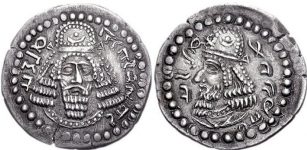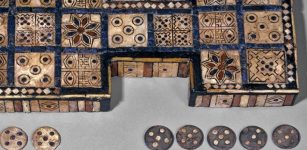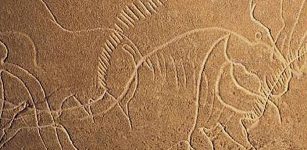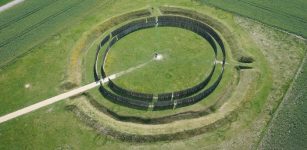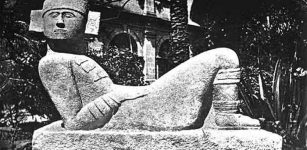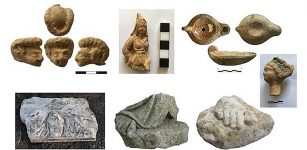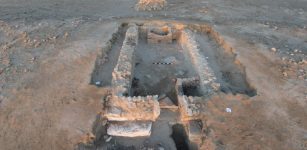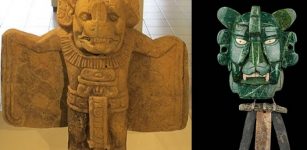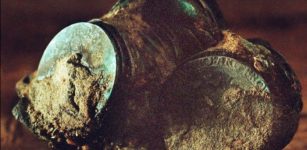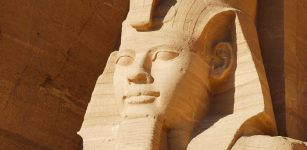Unique Ancient Bronze Miniature Portraits Of Alexander The Great Found In Ringsted On The Island Of Zealand
Jan Bartek - AncientPages.com - Two amateur archaeologists in Denmark have made a remarkable discovery. While surveying with a metal detector in a field near Ringsted, located on the island of Zealand, they unexpectedly detected an anomaly beneath the earth's surface. Upon closer inspection, they unearthed a small bronze artifact sticking out from the ground. The object was no larger than three centimeters in diameter.
The artifacts found at Ringsted is only 26-28 millimeters in diameter. The motif depicts Alexander the Great with ram's horns on the sides of his head, which he has after the god Zeus Ammon. Photo credit: Morten Petersen, Museum Vestsjælland
When experts examined the artifacts, they determined these were bronze miniature portraits of Alexander the Great. It is a truly unique discovery of great historical significance, says Freerk Oldenburger, an archaeologist at Museum Vestsjælland.
"It's fantastic. Up here in Scandinavia, you don't usually find anything about Alexander the Great, and when you stand with such a small portrait in your hands, you get excited," he adds.
Oldenburger explained the artifacts were produced around 200 A.D., an age called the Roman Iron Age. They were most likely ornaments attached to war shields.
Finn Ibsen and Lars Danielsen, the two amateur archaeologists who made the find, are often searching for objects together, and this discovery was especially exciting.
Ibsen detected the distinctive beeping, indicating something was concealed beneath the earth's surface. Upon excavating it, his eyes widened in surprise.
Finn Ibsen and Lars Danielsen have been walking with metal detectors since 2019. It was Finn Ibsen who spotted the fitting with Alexander the Great in a field near Ringsted.
Photo credit: Freerk Oldenburger, Museum West Zealand
Upon standing and jumping on the spot, I signal Lars to approach. He promptly responds, and upon his arrival, we see something extraordinary. "It is a face," Ibsen says.
Initially, they could not identify the face characterized by wavy hair and twisted ram's horns on its cheeks. The story only began to unravel when we submitted our discovery and subsequently received a call from Freerk Oldenburger. Ibsen says the exhilarating sensation of being transported 2,000 years into the past is indeed profound.
The bronze mini portraits of Alexander the Great are a rare find but other fascinating discoveries have also been made in the region.
In 1950, what at first glance looked like a lot of rusty junk was found at the bog in Illerup Ådal near Skanderborg.
This silver object was found in Illerup Ådal near Skanderborg. It was on a shield that was sacrificed around the year 200. It is currently on display at the Moesgaard Museum. Photo credit: Preben Dehlholm, Moesgaard Museum
Nearly 16,000 artifacts, including swords, bows, arrows, lances, and shields, were found upon closer inspection. These items were considered offerings to the deities following a significant battle in the region around AD 200. Intriguingly, one of the shields bore a gilded silver decorative disc featuring an image of Alexander the Great.
Alexander is considered one of history's greatest conquerors from antiquity. While Denmark often emphasizes its Viking heritage, Alexander the Great holds substantial historical significance outside Denmark, as Freerk Oldenburger explained.
See also: More Archaeology News
The fascination of Emperor Caracalla with Alexander the Great might explain why his image is found on artifacts 500 years after his death. However, its recent discovery near Ringsted remains an enigma.
Freerk Oldenburger suggests several possibilities for this occurrence. The existence of trade routes or the presence of individuals in Roman military service could have contributed to its journey here. Alternatively, it could result from Germans engaging in trade activities involving these items. Thus, there are numerous potential explanations for how it ended up at this location.
Written by Jan Bartek - AncientPages.com Staff Writer




